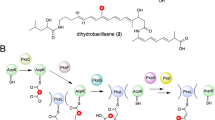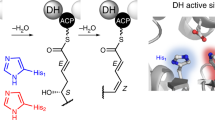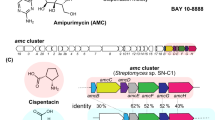Abstract
Biosynthesis of rhizoxin in Burkholderia rhizoxinica affords an unusual polyketide synthase module with ketosynthase and branching domains that install the δ-lactone, conferring antimitotic activity. To investigate their functions in chain branching, we designed chimeric modules with structurally similar domains from a glutarimide-forming module and a dehydratase. Biochemical, kinetic and mutational analyses reveal a structural role of the accessory domains and multifarious catalytic actions of the ketosynthase.
This is a preview of subscription content, access via your institution
Access options
Subscribe to this journal
Receive 12 print issues and online access
$259.00 per year
only $21.58 per issue
Buy this article
- Purchase on Springer Link
- Instant access to full article PDF
Prices may be subject to local taxes which are calculated during checkout


Similar content being viewed by others
Accession codes
References
Hertweck, C. Angew. Chem. Int. Ed. 48, 4688–4716 (2009).
Partida-Martinez, L.P. & Hertweck, C. Nature 437, 884–888 (2005).
Lackner, G., Partida-Martinez, L.P. & Hertweck, C. Trends Microbiol. 17, 570–576 (2009).
Scherlach, K., Busch, B., Lackner, G., Paszkowski, U. & Hertweck, C. Angew. Chem. Int. Ed. 51, 9615–9618 (2012).
Partida-Martinez, L.P. & Hertweck, C. ChemBioChem 8, 41–45 (2007).
Scherlach, K., Partida-Martinez, L.P., Dahse, H.-M. & Hertweck, C. J. Am. Chem. Soc. 128, 11529–11536 (2006).
Schmitt, I. et al. ISME J. 2, 632–641 (2008).
Kusebauch, B., Scherlach, K., Kirchner, H., Dahse, H.M. & Hertweck, C. ChemMedChem 6, 1998–2001 (2011).
Nguyen, T. et al. Nat. Biotechnol. 26, 225–233 (2008).
Kusebauch, B., Busch, B., Scherlach, K., Roth, M. & Hertweck, C. Angew. Chem. Int. Ed. 48, 5001–5004 (2009).
Bretschneider, T. et al. Nature 502, 124–128 (2013).
Heine, D., Sundaram, S., Bretschneider, T. & Hertweck, C. Chem. Commun. (Camb.) 51, 9872–9875 (2015).
Heine, D., Bretschneider, T., Sundaram, S. & Hertweck, C. Angew. Chem. Int. Ed. 53, 11645–11649 (2014).
Rajski, S.R. & Shen, B. ChemBioChem 11, 1951–1954 (2010).
Wang, B. et al. Org. Lett. 15, 1278–1281 (2013).
Lim, S.K. et al. J. Biol. Chem. 284, 29746–29756 (2009).
Yin, M. et al. Org. Lett. 16, 3072–3075 (2014).
Chen, S. et al. Chem. Biol. 10, 1065–1076 (2003).
Hothersall, J. et al. J. Biol. Chem. 282, 15451–15461 (2007).
Xu, Z. et al. ChemBioChem 15, 1274–1279 (2014).
Calderone, C.T. Nat. Prod. Rep. 25, 845–853 (2008).
Schneider-Poetsch, T. et al. Nat. Chem. Biol. 6, 209–217 (2010).
Bretschneider, T. et al. Nat. Chem. Biol. 8, 154–161 (2012).
Fuchs, S.W. et al. Angew. Chem. Int. Ed. 52, 4108–4112 (2013).
Zocher, G. et al. Chem. Sci. 10.1039/C5SC02488A (6 August 2015).
Kelley, L.A. & Sternberg, M.J. Nat. Protoc. 4, 363–371 (2009).
Ji, X.-Y. et al. Chem. Pharm. Bull. (Tokyo) 58, 1436–1441 (2010).
Acknowledgements
We thank A. Perner for MS analyses and M. Poetsch for MALDI measurements. We are grateful for financial support by the International Leibniz Research School (to S.S.) and the Studienstiftung des Deutschen Volkes (to D.H.).
Author information
Authors and Affiliations
Contributions
S.S. and C.H. designed experiments; S.S. performed genetic and biochemical experiments and analyzed data; D.H. synthesized substrates and reference compounds; and S.S. and C.H. wrote the manuscript.
Corresponding author
Ethics declarations
Competing interests
The authors declare no competing financial interests.
Supplementary information
Supplementary Text and Figures
Supplementary Results, Supplementary Notes 1 and 2 and Supplementary Figures 1–10. (PDF 3399 kb)
Rights and permissions
About this article
Cite this article
Sundaram, S., Heine, D. & Hertweck, C. Polyketide synthase chimeras reveal key role of ketosynthase domain in chain branching. Nat Chem Biol 11, 949–951 (2015). https://doi.org/10.1038/nchembio.1932
Received:
Accepted:
Published:
Issue Date:
DOI: https://doi.org/10.1038/nchembio.1932
This article is cited by
-
Isolation of new streptimidone derivatives, glutarimide antibiotics from Streptomyces sp. W3002 using LC-MS-guided screening
The Journal of Antibiotics (2020)
-
The hidden enzymology of bacterial natural product biosynthesis
Nature Reviews Chemistry (2019)
-
Automated structure prediction of trans-acyltransferase polyketide synthase products
Nature Chemical Biology (2019)
-
The Combinatorial Biosynthesis of “Unnatural” Products with Polyketides
Transactions of Tianjin University (2018)



